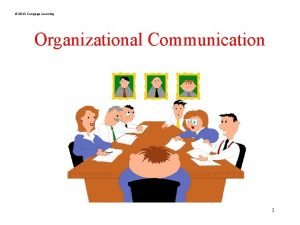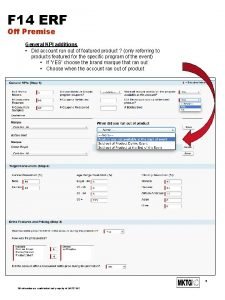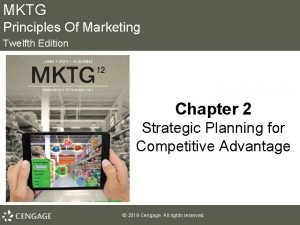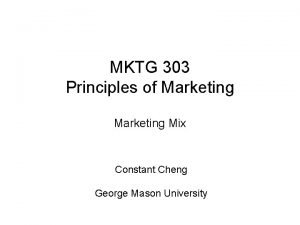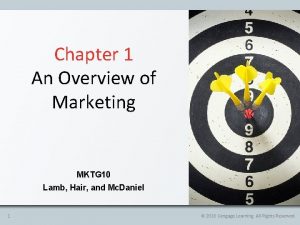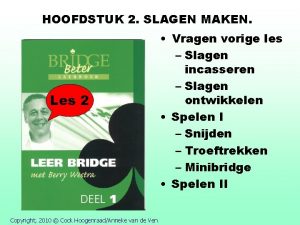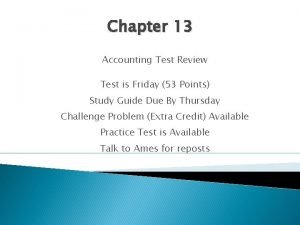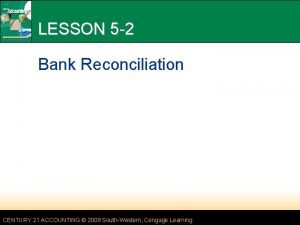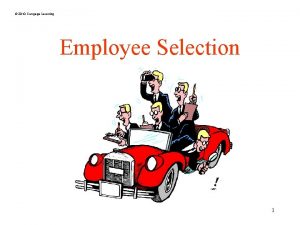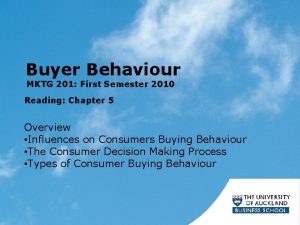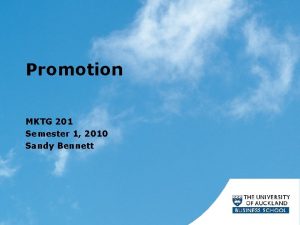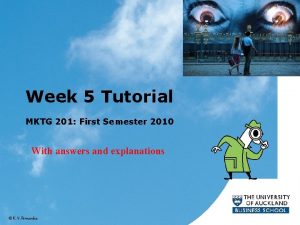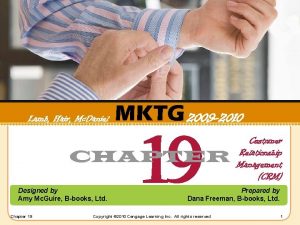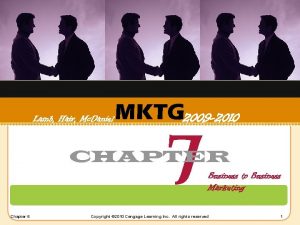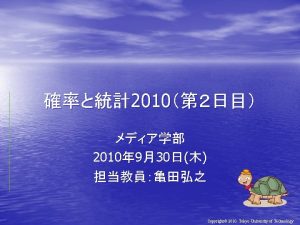MKTG 2 CHAPTER Chapter 2 Copyright 2010 Cengage








![Strategic Business Units (SBUs) Characteristics: [SBU HAS…] u A distinct mission and specific target Strategic Business Units (SBUs) Characteristics: [SBU HAS…] u A distinct mission and specific target](https://slidetodoc.com/presentation_image/5871d4f4791bc7b85b26432cbcad17a6/image-9.jpg)



























- Slides: 36

MKTG 2 CHAPTER Chapter 2 Copyright © 2010 Cengage Learning Inc. All rights reserved Strategic Planning for Competitive Advantage 1

………………. . The managerial process of creating and maintaining a fit between the organization’s objectives and resources and evolving market opportunities. The goal is long-term profitability and growth. LO 1 Chapter 2 Copyright © 2009 Cengage Learning Inc. All rights reserved. 2

Strategic Planning ………………… A written document that acts as a guidebook of marketing activities for the marketing manager. LO 1 Chapter 2 Copyright © 2009 Cengage Learning Inc. All rights reserved. 3

Why Write a Marketing Plan? u Provides a basis for comparison of actual and expected performance u Provides clearly stated activities to work toward common goals u Serves as a reference for the success of future activities u Provides an examination of the marketing environment u Allows entry into the marketplace with awareness LO 1 Chapter 2 Copyright © 2009 Cengage Learning Inc. All rights reserved. 4

Marketing Plan Elements Business Mission Statement Objectives Situation or SWOT Analysis Marketing Strategy Target Market Strategy Marketing Mix LO 1 Chapter 2 Product Distribution Promotion Price Implementation Evaluation Control Copyright © 2009 Cengage Learning Inc. All rights reserved. 5

Levels of Strategy § § Corporate Level Business Unit Level – § Functional Level – Chapter 2 SBU’s Marketing Copyright © 2009 Cengage Learning Inc. All rights reserved. 6

Defining the Business Mission u Answers the question, “What business are we in? ” u Focuses on the market(s) rather than the good or service u Strategic Business Units (SBUs) may also have a mission statement LO 2 Chapter 2 Copyright © 2009 Cengage Learning Inc. All rights reserved. 7

Chapter 2 Copyright © 2009 Cengage Learning Inc. All rights reserved. 8
![Strategic Business Units SBUs Characteristics SBU HAS u A distinct mission and specific target Strategic Business Units (SBUs) Characteristics: [SBU HAS…] u A distinct mission and specific target](https://slidetodoc.com/presentation_image/5871d4f4791bc7b85b26432cbcad17a6/image-9.jpg)
Strategic Business Units (SBUs) Characteristics: [SBU HAS…] u A distinct mission and specific target market u Control over its resources u Its own competitors u Plans independent of other SBUs LO 2 Chapter 2 Copyright © 2009 Cengage Learning Inc. All rights reserved. 9

LO 2 Business Mission Statement Q: What business are we in? A: Business mission statement Too narrow Too broad Just right Chapter 2 marketing myopia no direction focus on markets served and benefits customers seek Copyright © 2010 Cengage Learning Inc. All rights reserved 10

What Businesses are we in? Businesses must be viewed as CONSUMER-SATISFYING process and not goods-producing process. MARKETING MYOPIA. Chapter 2 Copyright © 2010 Cengage Learning Inc. All rights reserved 11

What Businesses are we in? Remember products are transient and basic NEEDS are not …. so, the key is to have a “market definition” of your business and not a product-based definition For example, is Xerox in the photocopying business? Chapter 2 Copyright © 2010 Cengage Learning Inc. All rights reserved 12

LO 3 Marketing Objective ………………… A statement of what is to be accomplished through marketing activities. Chapter 2 Copyright © 2010 Cengage Learning Inc. All rights reserved 13

LO 3 Marketing Objectives u Realistic u Measurable u Time specific u Consistent with and indicating the priorities of the organization “Our objective is to achieve 10 percent dollar market share in the cat food market within 12 months of product introduction. ” Chapter 2 Copyright © 2010 Cengage Learning Inc. All rights reserved 14

………………… Identifying internal strengths (S) and weaknesses (W) and also examining external opportunities (O) and threats (T) LO 4 Chapter 2 Copyright © 2009 Cengage Learning Inc. All rights reserved. 15

SWOT Analysis Internal External LO 4 Chapter 2 S W O T Things the company does well. Things the company does not do well. Conditions in the external environment that favor strengths. Conditions in the external environment that do not relate to existing strengths or favor areas of current weakness. ©South-Western College Publishing Copyright © 2009 Cengage Learning Inc. All rights reserved. 16

Environmental Scanning The collection and interpretation of information about forces, events, and relationships in the external environment that may affect the future of the organization or the implementation of the marketing plan. LO 4 Chapter 2 Copyright © 2009 Cengage Learning Inc. All rights reserved. 17

LO 5 Competitive Advantage …………………. Chapter 2 The set of unique features of a company and its products that are perceived by the target market as significant and superior to the competition. Copyright © 2009 Cengage Learning Inc. All rights reserved. 18

LO 5 Competitive Advantage Cost Types of Competitive Advantage Product/Service Differentiation Niche Strategies Chapter 2 Copyright © 2009 Cengage Learning Inc. All rights reserved. 19

LO 5 ………………. . Chapter 2 Being the low-cost competitor in an industry while maintaining satisfactory profit margins. Copyright © 2009 Cengage Learning Inc. All rights reserved. 20

LO 5 Product/Service Differentiation …………. Chapter 2 The provision of something that is unique and valuable to buyers beyond simply offering a lower price than the competition’s. Copyright © 2009 Cengage Learning Inc. All rights reserved. 21

LO 5 ………………… Chapter 2 The advantage achieved when a firm seeks to target and effectively serve a small segment of the market. Copyright © 2009 Cengage Learning Inc. All rights reserved. 22

LO 5 Niche Competitive Advantage u Used by small companies with limited resources u May be used in a limited geographic market u Product line may be focused on a specific product category Chapter 2 Copyright © 2009 Cengage Learning Inc. All rights reserved. 23

Marketing Strategy …………………. LO 7 Chapter 2 The activities of selecting and describing one or more target markets and developing and maintaining a market mix that will produce mutually satisfying exchanges with target markets. Copyright © 2010 Cengage Learning Inc. All rights reserved 24

LO 7 Target Market Strategies Target Market Options Entire Market Chapter 2 Multiple Markets Copyright © 2010 Cengage Learning Inc. All rights reserved Single Market 25

The Marketing Mix A unique blend of product, distribution, promotion, and pricing strategies designed to produce mutually satisfying exchanges with a target market. LO 8 Chapter 2 Copyright © 2010 Cengage Learning Inc. All rights reserved 26

Following Up on the Marketing Plan u Implementation u Evaluation u Control u Marketing audit is… u Comprehensive u Systematic u Independent 9 u Periodic LO Chapter 2 http: //www. youngbiz. com Online Copyright © 2010 Cengage Learning Inc. All rights reserved

Market Share § a company's sales expressed as a percentage of the sales for the total industry. Chapter 2 Copyright © 2010 Cengage Learning Inc. All rights reserved

Market Share § There are three firms in the market –P. Diddy, Puff Daddy, and Diddy (very confusing, I know!). P. Diddy sells 40 units, Puff sells 50 units, and Diddy sells 10 units. Compute the market shares of all three firms. Chapter 2 Copyright © 2010 Cengage Learning Inc. All rights reserved

Market Shares: Light Beer Brands Chapter 2 Copyright © 2010 Cengage Learning Inc. All rights reserved

Relative Market Share § Relative market share = Market share of specific brand / market share of the leader in the market Chapter 2 Copyright © 2010 Cengage Learning Inc. All rights reserved

Relative Market Share § In 1995, Makita enjoyed a 50% market share in the tradesmen segment. Milwaukee was second with 10% and Black & Decker was third in the market with 5%. Compute the relative market shares of the three brands. Chapter 2 Copyright © 2010 Cengage Learning Inc. All rights reserved

Boston Consulting Group’s Growth-Share Matrix Industry Growth (%) High STARS Low Chapter 2 CASH COWS PROBLEM CHILD DOGS High Relative Low Market Share Copyright © 2010 Cengage Learning Inc. All rights reserved

LO 6 Strategic Alternatives Market ………………. Chapter 2 Increase market share among existing customers Market ……………. . Attract new customers to existing products …………. . Development Create new products for present markets …………………. . Introduce new products into new markets Copyright © 2010 Cengage Learning Inc. All rights reserved

Competitive Growth Strategies MARKET PRODUCT Present Market Present Penetration Chapter 2 New Product Development Market Diversification Development Copyright © 2010 Cengage Learning Inc. All rights reserved

LO 6 Portfolio Matrix Strategies Build Hold Harvest Divest Chapter 2 Copyright © 2010 Cengage Learning Inc. All rights reserved
 Copyright cengage learning. powered by cognero
Copyright cengage learning. powered by cognero 2010 cengage learning
2010 cengage learning Bases for market segmentation
Bases for market segmentation Mktg erf
Mktg erf Mktg 12th edition
Mktg 12th edition Principles of marketing chapter 1
Principles of marketing chapter 1 Mktg 12th edition
Mktg 12th edition Differences between games and sports
Differences between games and sports Constant cheng
Constant cheng Mktg 10
Mktg 10 Copyright 2010 pearson education inc
Copyright 2010 pearson education inc C-929-a
C-929-a Variazioni finanziarie positive e negative
Variazioni finanziarie positive e negative Copyright 2010 pearson education inc
Copyright 2010 pearson education inc Copyright 2010 pearson education inc
Copyright 2010 pearson education inc Copyright 2010
Copyright 2010 Nwoz
Nwoz Copyright 2010 pearson education inc
Copyright 2010 pearson education inc Copyright 2010 pearson education inc
Copyright 2010 pearson education inc Copyright 2010 pearson education inc
Copyright 2010 pearson education inc 2010 pearson education inc
2010 pearson education inc Copyright 2010 pearson education inc
Copyright 2010 pearson education inc Copyright 2010 pearson education inc
Copyright 2010 pearson education inc Copyright 2010 pearson education inc
Copyright 2010 pearson education inc The human respiratory system chapter 7 handout
The human respiratory system chapter 7 handout Cengage chapter 7
Cengage chapter 7 2009 delmar cengage learning
2009 delmar cengage learning Chapter 13 study guide accounting
Chapter 13 study guide accounting Chapter 5 learning exercises medical terminology
Chapter 5 learning exercises medical terminology Chapter 8 the digestive system
Chapter 8 the digestive system Proximal medical term
Proximal medical term Chapter 4 the muscular system
Chapter 4 the muscular system Prescription terms
Prescription terms Cengage differential equations
Cengage differential equations Century 21 bank
Century 21 bank Separation of variables differential equations
Separation of variables differential equations Chapter 6:2 interpreting word parts
Chapter 6:2 interpreting word parts

